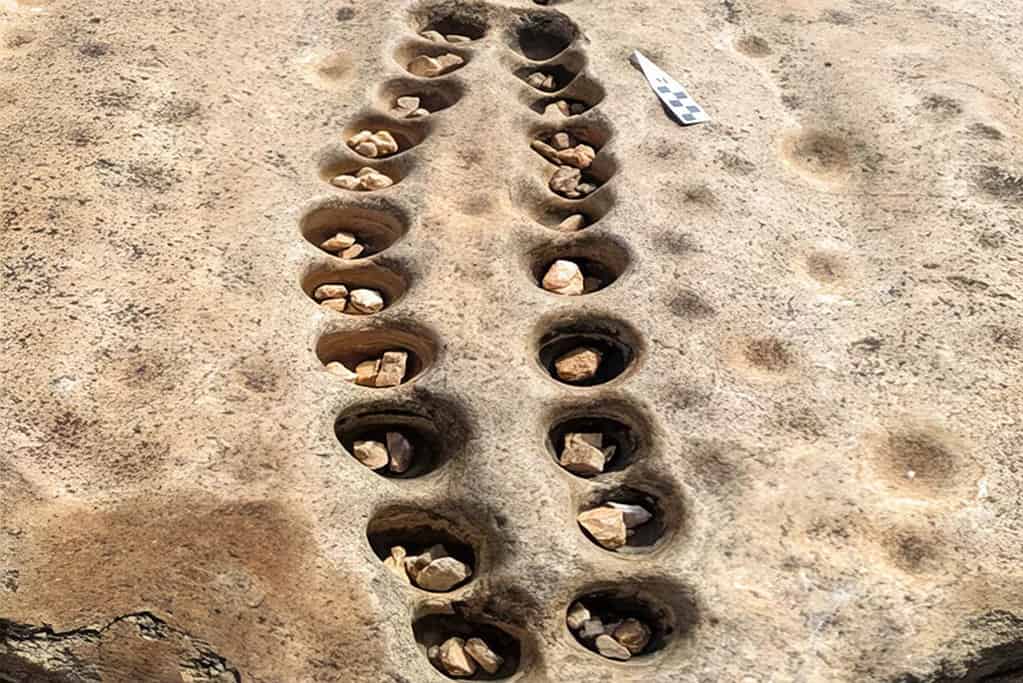
With some help from a local tour guide in Kenya, Veronica Waweru, an archaeologist from Yale University has found intriguing ancient shallow pits carved into a rock ledge, arranged in a pattern resembling a mancala board.
A total of 20 ancient mancala-board-like structures were discovered at the site. They are likely 5,000 to 10,000 years old and are located inside the Lewa Wildlife Conservancy in central Kenya.
“It’s a valley full of these game boards, like an ancient arcade. Given the erosion of some of the boards, I believe people were playing these games there a very long time ago,” Waweru said.
What’s mancala anyway?
Mancala refers to a family of turn-based dual-player strategy games. The games can be played on a ground surface with pits, or using any wooden or ivory mancala board.
The basic version of mancala uses a board with two rows of six pits, and a larger pit at each end called a “store.” The game begins with a set number of pieces (often seeds or stones) in each of the smaller pits. Players take turns picking up all the pieces from one of their pits, then dropping one piece into each pit counterclockwise around the board, including their own store but not their opponent’s store.
If the last piece lands in an empty pit on the player’s side, they capture that piece and any pieces in the opposite pit, placing all captured pieces into their store. The game ends when all six pits on one side of the board are empty. The player with the most pieces in their store at the end of the game wins.
There are over 200 versions and types of mancala games, yet the basic rules remain the same for most of them.
It is considered one of the oldest games in the world, dating back 8,000 years (6000 BCE). Historical records reveal that depictions of the game were also found on the roofs of some ancient Egyptian temples.
“Modern people in the region tend to play games like Mancala when they are out herding. That’s probably what they (ancient herding societies) were doing here. People tend to look at early life as brutish, nasty, and short. But perhaps life was not all about survival,” Waweru said.
The game is still quite popular in Africa and is played in many countries including Tanzania, Malawi, Mozambique, and Kenya.
Additionally, different versions of mancala with distinct names are played in North America and Western Europe (Kalah), India (pallankuzhi, also called pallanguzhi), and Indonesia (congklak).
The secret behind the ancient mancala boards
This isn’t the first time that archaeologists have found millennia-old mancala boards, but some of the other things that Waweru discovered around the boards in Kenya are unique.
For instance, she found evidence suggesting that people sharpened metal knives on the rocks lying near the ancient game boards.
“If they are sharpening knives there, they are probably feasting and performing butchery and barbecuing,” Waweru notes.
Moreover, the mancala boards were discovered near a site with 19 burial cairns belonging to ancient herding societies.
But why would people barbecue and play board games near a burial site?
The exact reason for this is not known but it could be possible the site was meant for performing some ancient ritual involving board games, butchering, and burials, according to the researcher.
Since the mancala boards were etched into a 400-million-year-old rock, and different pits have undergone different levels of erosion, it is challenging to figure out the exact age of the game boards.
“The site has been occupied over and over again throughout time,” Waweru said. It is possible that within the last 10 thousand years, people played Mancala there, Waweru added.
However, if we assume that it was ancient herding societies that first began playing the game here, then the mancala boards are probably 5,000 years old. This is because herders first inhabited the region around that time.
Waweru believes that DNA analysis of the burial cairns could reveal more information about the site and the mancala boards. She plans to continue studying this ancient arcade with her team to extract more valuable insights.









